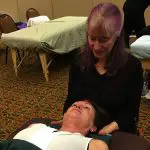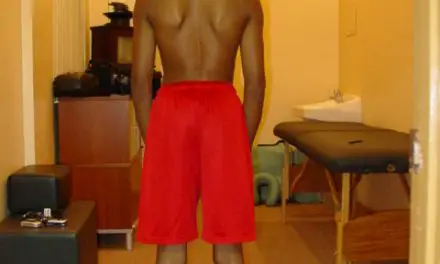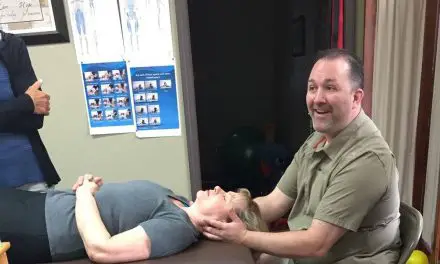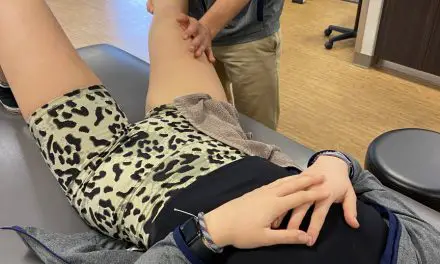Pregnancy is a special time in a woman’s life and comes with its own unique set of joys. It can also come with its own unique set of discomforts and stresses. What do you do when you have a headache or an achy back and you don’t want to take medications? A good prenatal massage may help relieve some of the common discomforts of pregnancy.
What is prenatal massage, and what types of massage techniques are used? In general, prenatal massage is similar to any pleasant full-body relaxation massage but with a few modifications that are specific to the special needs of pregnant women. The massage therapist will ask questions regarding your pregnancy. If you are early in the pregnancy and still able to lie on your stomach, the massage may proceed just like any relaxation massage. If you are later along and can no longer lie on your stomach, positioning on the massage table will be different to accommodate your growing belly.
When should you get a prenatal massage?
Any time you want to! Massage is great at any time during your pregnancy just as in the rest of life. However, there are some times when pregnant women commonly seek out massage. Many women especially enjoy prenatal massage during the last two months of their pregnancy.
As their pregnancy is in its final stages, they often start to feel increasingly uncomfortable in their bodies. They may have swelling in their arms and legs. Their joints may ache. Their back may ache. They may feel heavy and slightly out of sorts and just can’t wait for that baby to come. The last month in particular seems like a very long month and this is when pregnant women often crave massage. Pregnancy massage can soothe and relax and give some temporary relief until the baby comes.
Another particular time women seek massage is during their first trimester when they start to feel nauseous. Some women find that the massage gives them a pleasant distraction from the nausea.
A small study published in 2006 in the Scandinavian Journal of Caring Sciences found that women who were hospitalized with severe nausea found some relief with massage. Ten women in Sweden who were hospitalized because of pregnancy related severe nausea and vomiting were given “tactile massage” on three occasions during their stay in the hospital. After the last massage, the women were interviewed and asked about their experience with the nausea and vomiting and the massage.
The researchers reported, “The findings revealed an essential meaning summarizing the experience: to obtain a relieving moment of rest and access to the whole body when nausea rules life. When nausea is experienced as controlling a woman’s life, tactile massage is experienced as promoting relaxation and gives her an opportunity to regain access to her body. The findings suggest that tactile massage is a good alternative and complement to traditional treatment of SNVP.(severe nausea and vomiting during pregnancy).”
Another study found that massage reduced nausea in women undergoing chemotherapy for breast cancer. Thirty-nine women were randomized into two groups, one group receiving 20 minutes of massage for five sessions and the other group receiving no massage. The massage group reported significantly less nausea than the control (non-massage) group.
If you are experiencing nausea, you might want to give this a try. If you’re concerned that lying down might make you feel worse or make you vomit, a seated massage that allows you to stay upright may be an option. If you want to try seated massage rather than lying down, make sure your massage therapist provides this. Not all therapists are set up to do seated massage.
Some women habitually get a regular massage and continue it throughout their pregnancy. It is part of their wellness routine and there is no reason to interrupt their regular massage sessions. Very active individuals may start getting massages regularly as a way of learning to relax in preparation for labor and motherhood. If you’ve had a stressful day at or life in general has been stressful, prenatal massage is a great way to cope with that. Massage may provide relief for headaches, anxiety, or mild depression without medication.
Any time during pregnancy is a good time to get a massage! You don’t need a reason, you can do it just because you want a nice, relaxing experience.
Pregnancy massage myths
All cultures have taboos and myths about pregnancy and the world of massage therapy is no exception. One of the most common myths is that the feet and ankles of a pregnant woman should not be massaged. Why? In both Chinese and American foot reflexology, it is believed that there are “reflex points” on the feet and ankles that correspond to the uterus and that stimulating them with massage may cause a woman to miscarry or go into premature labor. Indeed, some massage therapists claim they can induce labor by massaging the feet and ankles.
If only this were true! It would end the need for medically induced labor. Unfortunately, it is not that easy. A 2017 Cochrane Review examined studies on acupressure (pressure to specific points) for the purpose of labor induction in women past their due date. Cochrane reviews look at all the available studies to see what the overall evidence is regarding the effectiveness of a given treatment for a given purpose.
Looking at several studies, they found “There was no evidence of benefit from acupressure in reducing caesarean sections compared to control . . . There was no evidence of a clear benefit in reduced oxytocin augmentation, instrumental vaginal birth, meconium‐stained liquor, time from trial intervention to birth of the baby, and spontaneous vaginal birth. . . There was no evidence of a clear benefit in reduced epidural analgesia, Apgar score < 7 at 5 minutes, admission to neonatal intensive care, time from trial intervention to birth of the baby, use of other induction methods, and spontaneous vaginal birth.”
In plain language: acupressure massage to induce labor did nothing to induce labor. While that may be a disappointment to some who would love a safe and easy way to naturally induce labor, the good news is that it’s okay to have your feet and ankles massaged at any stage of pregnancy.
The first trimester
Another common prenatal massage myth is the belief that massage should not be done during the first trimester of pregnancy. There is no reason to avoid massage at any time during a normal pregnancy. Most women don’t even know they are pregnant until they are well into their first trimester. Where did this myth come from? It is probably based on a fear of litigation.
Most miscarriages occur during the first trimester and massage therapists fear that if a woman has massage and later has the misfortune to have a miscarriage, the massage therapist might be blamed. While this fear may appear understandable, the reality is that there is no documented evidence of a single case of massage being blamed for a miscarriage. Go ahead and enjoy massage during any trimester.
Releasing toxins
Another common myth is that massage releases unnamed “toxins” and that this will do harm to the developing baby. Exactly which toxins or how does massage do this? No one seems to know. There is some vague idea that our bodies are toxic waste dumps that are ready to release dreadful chemicals into our bloodstream. There is no physiological reason to believe this and it really doesn’t make sense.
Why would our body release poisonous chemicals at the same time it is trying to grow and protect new life?
Some go so far as to tell nursing mothers that after a massage they should pump their breast milk and discard it because these vague toxins could get into the breast milk. The body works hard to make that milk; it doesn’t need to be dumped. You don’t need to worry that massage will release anything toxic.
Trigger points
You may have heard massage therapists talk about “trigger points.” What are they? They are small tender areas that, when pressed, can radiate pain and other sensations. They are usually associated with chronic pain but they may also be silent and only obvious when they are pushed on. We know that these tender areas exist and most of us have them but no one knows exactly what they are or exactly how significant they might be.
Pushing on them can be painful and prenatal massage should not be painful, so there is no need to focus on them during pregnancy. Sometimes it can feel good to apply some pressure on them when there is some ongoing ache, like low back ache or ache near the shoulder blades. If moderate pressure on one of these areas feels good, then by all means enjoy it, but don’t let the therapist get too heavy handed.
Prenatal massage does not need to be feather light but pressure should stay moderate and comfortable. Ironically, this is one case where massage itself could release “toxins” if too much pressure is used. Dr. Janet Travell and Dr. Dave Simons, in their two volume text The Trigger Point Manual, cited a small 1983 study published in the Scandanavian Journal of Rehabilitative Medicine that suggested pushing hard on these points could rupture muscle cells and spill myoglobin into the bloodstream where it does not belong.
Ten women with what was then called “fibrocitis” (trigger points) had massage to these painful areas. After massage specifically to these painful areas a blood sample was analyzed and detectable levels of myoglobin were found in their blood. It was not found in their blood before the massage. Myoglobin is a component of muscle cells and belongs there. However, it does not belong in the blood.
When large amounts of myoglobin enter the bloodstream, usually through trauma or extreme exercise, it can cause a potentially dangerous condition called rhabdomyolysis, also known as “rhabdo.” While it’s doubtful that some pressure on a few of these points are going to cause harm, there is no reason to irritate them, cause pain, and potentially injure muscle cells and blood vessels. Prenatal massage should relax the mother, not hurt her.
Is prenatal massage safe?
Gentle, relaxing, full-body massage during a normal pregnancy is safe during any trimester from beginning to end. However, there are times when it should be avoided. If you have recently experienced bleeding, pre-term contractions, any sudden pains or severe headaches, consult your health care provider before booking an appointment for massage.
Any condition outside of the norm, such as a high risk pregnancy, pre-eclampsia, severe swelling, previous pre-term pregnancy, or pregnancy induced high blood pressure, should also be discussed with your health care provider before receiving massage.
Pregnant women are five times more likely to form blood clots than women who are not pregnant so any signs or symptoms should be checked by a doctor before receiving massage. Fortunately, only one or two pregnant women out of 1,000 will develop a blood clot so there is no need for alarm, but since they tend to form on the inner thigh or inside of the pelvis, any sudden pain, or the presence of redness and warmth should be investigated.
What to expect in a prenatal massage
When you book your appointment for a massage, let your therapist know right away that you are pregnant and how far along you are. Not all massage therapists offer prenatal massage and you don’t want to show up and be turned away. Also, the therapist may need to set up their massage table differently and this will allow them to be prepared for you when you arrive.
You may want to ask if the therapist uses any essential oils or fragrances. Pregnant women can be very sensitive to odors. If that’s true in your case, you may want to let the therapist know in advance. There is very little research about the effect of essential oils during pregnancy, though there is evidence that inhalation of lavender oil can be very relaxing and that it may alleviate symptoms of anxiety and depression. Lavender is generally regarded as safe and widely used but some sources, such as the Mayo Clinic, discourage applying it to the skin during pregnancy because of the lack of research.
If you’ve had massage before, you will be familiar with the usual routine. If you have not had massage before, most massage therapists will have you fill out an intake form asking for your contact information and common questions about your health history. This is a great time to use the restroom one last time so you don’t need to interrupt your massage with a trip to the bathroom.
When you are introduced to your massage therapist, they will take you to the massage room, look over your form, and ask more specific questions.
Sometimes people wonder why massage therapists ask all these questions, but it is important for the therapist to know if there are any modifications they need to make during the massage. The therapist will ask about your reason for massage: Relaxation? Backache? Headache? Some may ask more detailed questions about how your pregnancy is proceeding. If you have questions you would like to ask the therapist, this is an excellent time to do that.
The therapist will discuss how you will be positioned if you are past the point of being able to lie comfortably on your belly. Some therapists only do pregnancy massage in a side-lying position – that is, you will lie on your side and pillows and bolsters will be used to comfortably support you.
Others have some sort of support system for massage in a face-down position. It could be a large pillow with a depression in it to accommodate your growing belly, a special bolster, or it could be a table with a cutout and an adjustable support underneath for the belly.
If this is the case, you have a choice of having a massage in a side-lying position or face down, whichever you prefer. If you choose face down and after a few minutes decide that you would rather be on your side, let the therapist know and you can change positions.
The therapist will step out while you undress. Some people prefer to remove all of their clothes; others prefer to keep on their underwear. Whatever you prefer is fine. You’ll be draped with a sheet during the massage and the therapist will uncover the area where they are working, then replace the drape. The therapist usually will knock before re-entering the room and will adjust the pillows, bolsters, etc. so that everything is in the right place.
Tell the therapist if you are uncomfortable for any reason. Don’t be afraid to speak up. Your massage therapist wants you to have a good experience and since each of us have our own unique set of preferences, the therapist is happy to accommodate yours. Let them know if the pressure is too heavy or too light, if you need to change position or have the supports adjusted. You are not being a bother! It’s important that you are able to fully relax during your massage.
You may find that pressure that the amount of pressure that is comfortable will be different from one part of the body to another. It may be fine on your back if there is too much on your legs or other places. Don’t worry, that’s common. Let your therapist know so they can adjust to your comfort level so you can relax and enjoy the experience of soothing touch.
Some people like to chat while they are having a massage and sometimes a brief period of talking can help them unwind and begin to relax. Many people enjoy being quiet and allowing themselves to drift into a wonderful state of pure bliss. If you are having problems with aches, the therapist will probably need to disturb your reverie a bit to ask relevant questions so they know exactly where they need to focus their attention. Outside of that, let yourself sink into the table and allow yourself to be nurtured.
Depending on how you are positioned for the massage, the therapist may or may not have you lie on your back for part of your massage. If you are later in your pregnancy, they will prop you with pillows or bolsters so that you are in a semi-reclined position.
Again, let your therapist know if you need to reposition yourself or have a bolster or pillow adjusted. You should be comfortable so that you can relax. If you are further along in your pregnancy, the massage therapist may or may not massage your belly. If you have a preference, let them know. It’s okay to ask the therapist not to massage particular areas if that’s what you want and it’s okay to ask for focused attention on areas that need it. It’s your massage and your therapist wants to give you a good experience within their ability to do it.
Eventually, all massages must come to an end. The therapist will step out so that you can get dressed. If you think you will need help getting up, let them know before they leave the room. Get up slowly and allow yourself to sit for a moment. Occasionally people will feel a bit light headed after massage, even when they aren’t pregnant, so you want to monitor how you feel before jumping to your feet.
Once you are dressed, either the therapist will return or you may be told to check out at the reception desk. If you have any comments you wish to share with the therapist, please do.
Most people feel very good after massage. They feel relaxed physically and mentally. Aches are usually reduced or even gone for now. You may feel that you move with more ease or feel taller. Enjoy the feeling. How long does it last? That depends on the individual but the enjoyment usually does persist after the massage is over.
How to find a good prenatal massage therapist near you
Okay, now that you’ve decided you would like to book an appointment for a prenatal massage, how do you find a good therapist who is right for you? There are a number of options. You can ask your doctor, nurse practitioner, midwife, or other health care practitioner if they can recommend a massage therapist who does prenatal massage.
If you are in any sort of prenatal class—prenatal yoga or birth education, for instance—ask your fellow students or the instructor if they can recommend a good massage therapist. Ask your friends and relatives.
You can search on the internet. Both the Associated Bodywork and Massage Professionals (ABMP) and the American Massage Therapy Association (AMTA) have a “Find a massage therapist near you” function on their websites. Look for one near you. It may or may not indicate whether they do pregnancy massage. If they do not, ask if the know a therapist who does that they can recommend.
Finally, you can look in google for “prenatal massage” or “prenatal massage near me” Look at their website or reviews. Do they seem professional? Do they explain anything about their training or experience?
If you have an opportunity to speak with the therapist when you call for an appointment, ask about their training and experience or any other questions you may have. Ask about their approach to massage, in what kind of setting do they practice? Listen to how they answer.
Do they listen to you? Answer your questions in a way that makes sense to you? Do you feel confident about them? If the answers are yes, make an appointment and see how they work out for you. If not, keep looking.
A massage therapist may tell you that they are “certified” in prenatal massage or you may be told to look for a therapist certified in prenatal massage. There is no bona fide certification in prenatal massage. What therapists mean by this term is that they took a specific class in prenatal massage and have a certificate of attendance.
There are some therapists whose training included prenatal massage and therefore they have no special certificate of attendance at an outside massage class. What is most important to know is does the therapist have experience doing prenatal massage and do they enjoy doing it?
That last factor is important. Some massage therapists are qualified to do pregnancy massage but don’t do it very often or do not enjoy doing it because they find the different positioning awkward. Asking how much prenatal massage they do may help, though some enjoy doing it but don’t have many requests. However, if they sound happy to do it, that’s a good sign, and if they don’t, you may want to keep looking.
Sometimes it can take trying a few different therapists to find the one that is really right for you. The interaction between client and therapist is very personal and many factors are involved in a good experience. If you find a great massage therapist on your first appointment, congratulations! Let them know and tell your friends, especially other pregnant women, so that they can have a great prenatal massage, too.
Massage therapy is great. It feels good and can relieve aches and pains. It is safe throughout any normal pregnancy. If there are any health concerns, speak to your health care provider before booking an appointment for massage.
Congratulations on your coming baby. Now go find a good massage therapist and enjoy an awesome prenatal massage!

Alice Sanvito, LMT
Alice is a massage therapist who maintains a private practice in St. Louis, MO, She has been committed to client-centered, science-compatible massage therapy since 1991. She assisted at NMT seminars for the NMT Center of St. Petersburg, Florida, for 10 years and studied Russian Medical and Sports Massage with the late Zhenya Kurashova Wine for over 10 years, under whose direction she taught Russian Massage for three years.
Most recently she has studied DNM under physiotherapist Diane Jacobs. Alice has a particular interest in pain rehabilitation and enjoys working with performing artists, athletes, and pregnant women. When not devoted to her practice, you can find her playing old time music and dancing every chance she gets.





